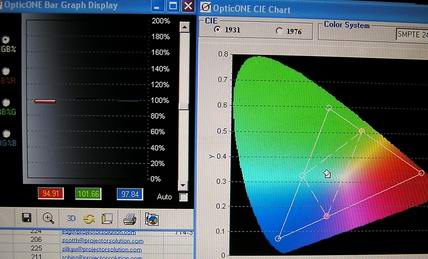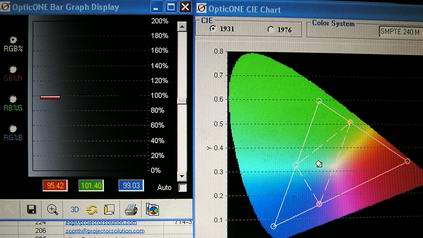Color accuracy
In a perfect world, any screen will reflect back the same balance of color that hits it. Some screens are better at this than others. While I am no expert on how to best determine the color accuracy of a screen, I came up with a method that should provide a good idea.
Using our Optic One Light meter, and projecting a 100 IRE (white) image on to the screen from a projector, I first placed the light meter directly in front of the screen and measured the light balance. The projector used was the Optoma HD72,
Measured the light balance
Measured the light balance

White Measurements Reflected
previously calbrated. At 100 IRE the white was off only slightly on the projector from the desired 6500K. The first image shows the measurement diamond virtually on top of the square (desired) target. On the left you can see that the readings are just a little down on red, at 95.42, and almost perfect on Green - 101.40, and blue 99.03.
I then turned the light meter toward the white light reflected off the screen, and repeated the process. As you can see from this image there is a slight shift in the color, but by any standard very slight. The variation of most projectors when measured at different IRE (gray levels, is typically this great or greater). That would indicate that this screen is extremely neutral, and for perfectionists, easy to adjust the calibration of any projector to compensate.
The red value dropped insignificantly to 94.91, the green remained the same increasing only 0.26% to 101.66, and the blue, dropped slightly more than 1% to 97.84. Now that's pretty impressive.
Screen Brightness
The Brilliant White screen surface claims a gain of 1.4. As with screens with gain, brightness will diminish as you view the screen off access. I again measured the brightness of the projector on the light meter, and then, without the diffuser, measured light reflecting off the screen. This is not an accurate method of measure for several reasons, but the numbers yielded a gain of just under 1.3. Due to the slight off angle of the light meter, I expected the measurement to yield a lower gain than actual. Based on this, I find the 1.4 claim to be very reasonable.
Screens with gain, by nature, focus light. The result is that as you move off angle, you must expect brightness to diminish. A gain of 1.4 generates very modest roll off, and almost no hot spot compared to higher gain screens with gains approaching 2.0 or beyond. Based on subjective viewing this screen rolls off modestly as would be expected as one moves off angle. If you are sitting far enough back, you could easily sit well outside the left or right edge of the screen. With the 106" diagonal screen (92" wide), at a distance of 12 feet, I would recommend best seating to be within 6-7 feet of center (a 12-14 foot wide seating area). With a screen this size, that should easily allow four, wide theater seats (40" wide each) in the first row, or five..
Moving another 2-4 feet to the side, causes only minor additional change, not drastic., So, five, or even six wide home theater style seats is very doable.The center three seats would be almost perfect, but the outermost seats will be virtually as good. . I would say acceptable viewing would be up to 9 feet from center at the same 12 foot distance. In other words, unless you have an excessively wide room, the roll off should not be an issue at all.
Most impressively, there is virtually no hot spot visible. Even when I shine a pure white image, or a blue screen (which makes it far easier to detect a hot spot then normal viewing content) , I could barely detect any. I can definitely state that my other screen, the 128" Stewart Firehawk which is a high contrast light gray screen has noticeably more of a hot spot, as it is expected to. being that it is better at rejecting ambient light from the sides. A fair trade off. And on that note, the Brilliant White surface is not going to be your first choice if you do want to limit ambient light coming from the sides.



